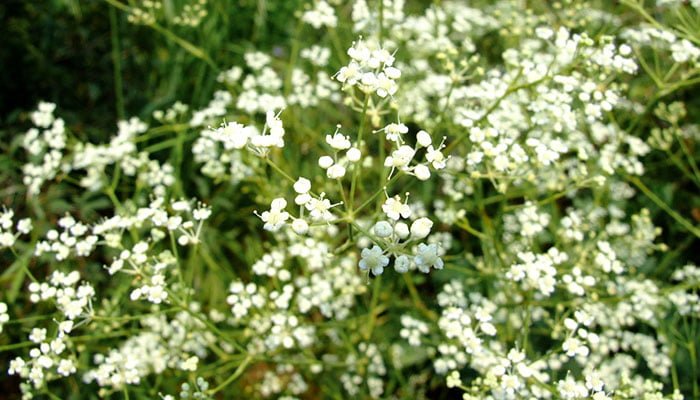What Is Fang Feng
Fang Feng also known as Radix Saposhnikoviae or Siler Root is the root of Saposhnikovia divaricata, which is a perennial herb belonging to the family Umbelliferae. It is a relatively practical and common Chinese herbal medicine, which first appeared in <Shennong Ben Cao Jing> in the late Western Han Dynasty (around 100 BCE).
Saposhnikovia divaricata is resistant to cold and drought. They grow well in sandy loam with high terrain, sunny, loose, fertile, deep soil, and good drainage. They often grow on grasslands, hills, and gravel slopes. They are distributed in China, Mongolia, Russia, Japan, and South Korea.
In spring and autumn, people gather the roots of Saposhnikovia divaricata, remove their fibrous roots and sand, dry them in the sun, cut them into slices, use them directly, or carbonize them, and make them into Chinese herbal medicines.

Fang Feng contains prim-o-glucosyl-cimifugin, cimifugin, 4′-o-β-glucosyl-5-o-methylvisamminol, hamaudol, noreugenin, undulatoside A, 3′-O-propionylhamaudol, scopoletin, bergapten, isoimperatorin, marmesin, oxypeucedanin, osthenol, fraxidin, isofraxidin, bergapten, psoralen, xanthotoxin, imperation, phelloptern, deltoin, anomalin, nodakenetin, andumbelliferone, sapodivarin, isobergapten, decursinol angelate, fangfengalpyrimidine, clemiscosin A, β-sitosterol, daucosterol, polysaccharides, volatile oils, fatty acids, glycerides, and some trace elements.
Generally, the easily broken Fang Feng with a brown-yellow to brown cross-section, and light yellow wooden parts is preferred.
According to <Compendium of Materia Medica>, the medicinal nature of Fang Feng is slightly warm, with a pungent and sweet taste. It has a certain therapeutic effect on the pathological changes of the bladder, liver, and spleen meridians.
In traditional Chinese medicine, it is often used to dispel wind and relieve exterior symptoms, eliminate dampness and relieve pain, relieve spasm, treat headaches due to colds, rheumatic arthralgia, tetanus, herpes simplex keratitis, facial neuritis, allergic asthma, postpartum external genital swelling, flat warts, fungal vaginitis, Leylo’s disease, gangrene of digits, concussion, allergic purpura, psoriasis, urticaria, upper respiratory tract infection, viral hepatitis, extraocular muscle paralysis, and arsenic poisoning.
There are about 300 kinds of Chinese medicine prescriptions containing it, such as Fang Feng Tong Sheng Wan, Yu Ping Feng San, and Jiu Wei Qiang Huo Wan.
Benefits
- Anti-inflammation, inhibiting the ear swelling of mice caused by xylene.
- Anti-oxidation, scavenging hydroxyl free radicals and DPPH free radicals.
- Reducing the body temperature of rats with fever caused by 2,4-dinitrophenol or dry yeast.
- Raising the pain threshold and inhibiting the pain caused by the hot plate test and the acetic acid test.
- Inhibiting the adhesion function of rabbit platelets, thereby inhibiting the formation of thrombus.
- Extending prothrombin time and reducing plasma viscosity.
- Inhibiting the contraction of isolated guinea-pig ileum smooth muscle caused by histamine, and antagonizing the anaphylactic shock caused by ovalbumin.
- Relieving exterior symptoms, treating headache and body pain caused by wind-cold, wind-heat, or wind-damp.
- Dispelling wind, treating urticaria and itching caused by pathogenic wind.
- Expelling wind and eliminating dampness, treating rheumatic arthralgia, limbs pain, and spasm of limbs.
- Treating redness, swelling, heat, and pain in the joint caused by wind-cold damp pathogen stagnation transforming into heat.
- Resting wind and relieving spasms, treating muscle cramps, twitching of limbs, rigidity, and pain of neck and nape, and opisthotonos caused by tetanus.
- Sending up the lucid yang and drying dampness, treating diarrhea caused by damp abundance due to splenic asthenia.
- Its methanol extract cooperates with pentobarbital sodium to extend the sleep time of experimental mice.
- Its polysaccharides can improve mouse-specific immunity and cellular immunity, and promote the proliferation of mouse spleen lymphocytes.
- Inhibiting Staphylococcus aureus, type II hemolytic streptococcus, pneumococcus, dysentery bacillus, and bacillus subtilis.
- Studies have found that its polysaccharides can increase the bone density of osteoporotic rats after ovariectomy.
Combinations
- It can be used in combination with Jing Jie (Schizonepeta Tenuifolia), Qiang Huo (Rhizoma et Radix Notopterygii), Du Huo (Radix Angelicae Pubescentis), etc.to treat headaches, body pains, and aversion to wind and cold caused by wind-cold.
- It can be used in combination with Qiang Huo (Rhizoma et Radix Notopterygii), Gao Ben (Rhizoma Ligustici), Qiang Huo (Rhizoma et Radix Notopterygii), etc. to treat tightly-wrapped pain in the head, heavy body, and melagra.
- It can be used in combination with Bo He (Mentha), Chan Tui (Periostracum Cicadae), Lian Qiao (Fructus Forsythiae), etc. to treat fever, aversion to wind, eye pain, and thirst caused by wind-heat.
- It can be used in combination with Tu Fu Ling (Rhizoma Smilacis Glabrae), Bai Xian Pi (Cortex Dictamni), Chi Xiao Dou (Adzuki Bean), etc. to treat eczema and itching caused by damp-heat.
- It can be used in combination with Qiang Huo (Rhizoma et Radix Notopterygii), Du Huo (Radix Angelicae Pubescentis), Gui Zhi (Ramulus Cinnamomi), Jiang Huang (Rhizoma Curcumae Longae), etc. to treat rheumatic arthralgia, limbs pain, and spasm of limbs.
- It can be used in combination with Tian Ma (Rhizoma Gastrodiae), Tian Nan Xing (Rhizoma Arisaematis), Bai Fu Zi (Typhonii Rhizoma), etc. to treat muscle cramps, twitching of limbs, rigidity and pain of neck and nape, and opisthotonos caused by tetanus.
Side Effects
- Modern animal studies have shown that Fang Feng is slightly toxic.
- Overdose may cause sweating or thirst.
- Individual patients taking it may cause allergic reactions, such as abdominal discomfort, nausea, vomiting, skin itching, or erythema.
Precautions and Warnings
- The dosage of Fang Feng should be controlled at 5-10g.
- It can be made into decoctions, pills, powders, or lotions.
- People who are allergic to windproof should not take it.
- It should not be taken at the same time as Gan Jiang (Dried Ginger), Bai Lian (Radix Ampelopsis), Bai Ji (Rhizoma Bletillae), Li Lu (Veratrum Nigrum), and Yuan Hua (Genkwa Flos).
- Patients with a deficiency of yin and blood should not take it.
- Patients with constipation should not take it.
- Patients with feel sick should not take it.
- Pregnant women and breastfeeding women should take it under the guidance of a doctor.
